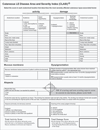Development of the CLASI as a tool to measure disease severity and responsiveness to therapy in cutaneous lupus erythematosus
- PMID: 21339447
- PMCID: PMC3282059
- DOI: 10.1001/archdermatol.2010.435
Development of the CLASI as a tool to measure disease severity and responsiveness to therapy in cutaneous lupus erythematosus
Abstract
Objective: To determine how to use the Cutaneous Lupus Erythematosus Disease Area and Severity Index (CLASI) to classify patients according to disease severity (mild, moderate, and severe) and to identify which patients respond to therapy.
Design: Cohort.
Setting: The connective-tissue disease clinic at the Hospital of the University of Pennsylvania, Philadelphia.
Patients: Seventy-five patients with clinical or histopathologic evidence of cutaneous lupus erythematosus or systemic lupus erythematosus were included in the study.
Main outcome measures: The CLASI, Skindex-29, and the physician's subjective assessment of severity and improvement were completed at every visit.
Results: Disease severity was assessed with 45 patient visits. Mild, moderate, and severe disease corresponded with CLASI activity score ranges of 0 to 9, 10 to 20, and 21 to 70, respectively. Improvement in disease activity was assessed in 74 patients. A clinical improvement was associated with a mean 3-point or 18% decrease in the CLASI activity score. However, receiver operating characteristic analysis demonstrated an increased percentage of patients correctly classified when a 4-point (sensitivity, 39%; specificity, 93%; correctly classified, 76%) or 20% (sensitivity, 46%; specificity, 78%; correctly classified, 67%) decrease in the CLASI activity score was used instead to identify improvement.
Conclusion: The CLASI can be used to classify patients into groups according to disease severity and to identify clinically significant improvements in disease activity.
©2011 American Medical Association. All rights reserved.
Conflict of interest statement
Figures



References
-
- Erceg A, Bovenschen HJ, van de Kerkhof PC, de Jong EM, Seyger MM. Efficacy and safety of pulsed dye laser treatment for cutaneous discoid lupus erythematosus. J Am Acad Dermatol. 2009 Apr;60(4):626–632. - PubMed
-
- Kreuter A, Gaifullina R, Tigges C, Kirschke J, Altmeyer P, Gambichler T. Lupus erythematosus tumidus: response to antimalarial treatment in 36 patients with emphasis on smoking. Arch Dermatol. 2009 Mar;145(3):244–248. - PubMed
Publication types
MeSH terms
Grants and funding
LinkOut - more resources
Full Text Sources
Other Literature Sources

